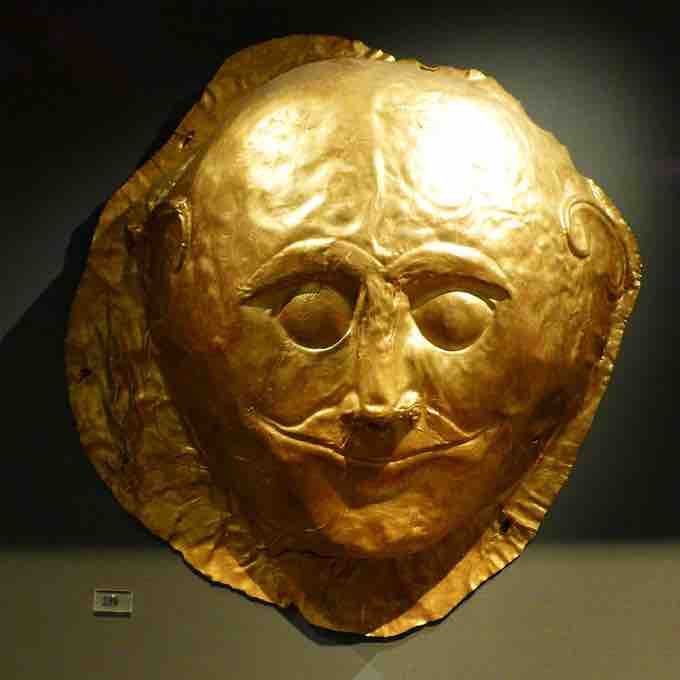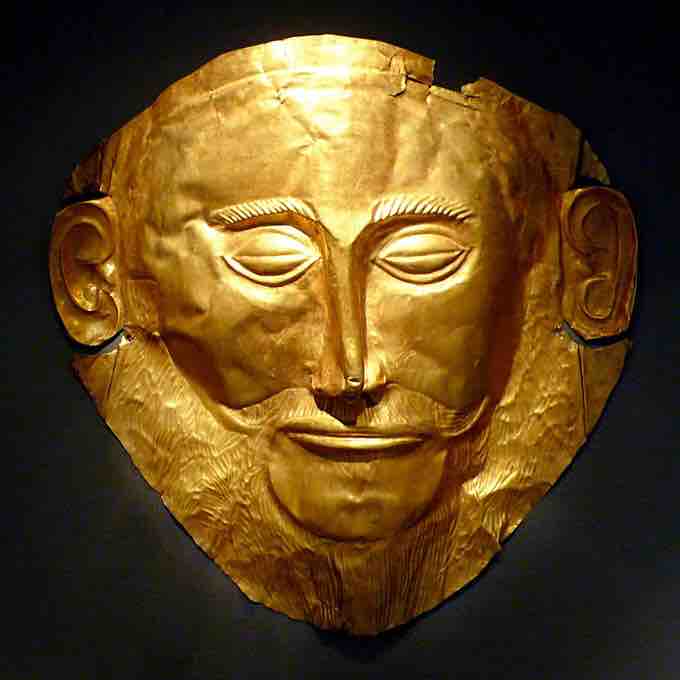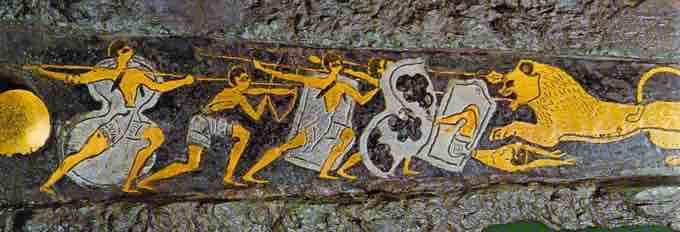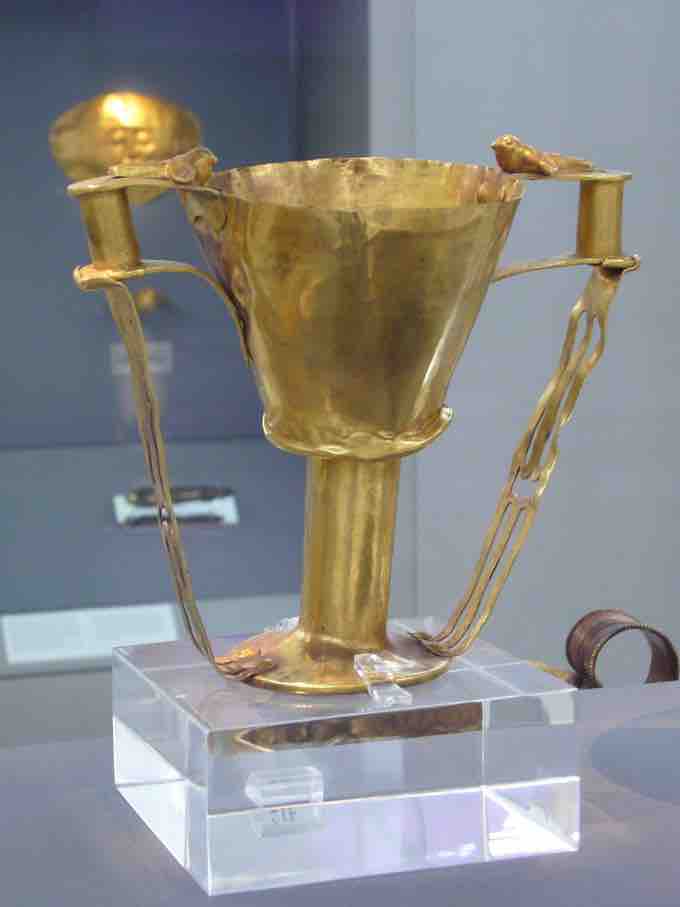Grave Circle A at Mycenae
Grave Circle A is a set of graves from the sixteenth century BCE located at Mycenae. The Grave Circle was originally located outside the walls of the city but was later encompassed inside the walls of the citadel when the city's walls were enlarged during the thirteenth century BCE. The grave circle is surrounded by a second wall and only has one entrance. Inside are six tombs for nineteen bodies that were buried inside shaft graves. The shaft graves were deep, narrow shafts dug into the ground. The body would be placed inside a stone coffin and placed at the bottom of the grave along with grave goods. The graves were often marked by a mound of earth above them and grave stele.
The grave site was excavated by Heinrich Schleimann in 1876, who excavated ancient sites such as Mycenae and Troy based on the writings of Homer and was determined to find archaeological remains that aligned with observations discussed in the Iliad and the Odyssey. The archaeological methods of the nineteenth century were fairly different than those of the twenty-first century and Schleimann's desire to discover remains that aligned with mythologies and Homeric stories did not seem as unusual as it does today. Upon excavating the tombs, Schleimann declared that he found the remains of Agamemnon and many of his followers.
An additional grave circle, Grave Circle B, is also located at Mycenae, although this one was never incorporated into the citadel site. The two graves circles were elite burial grounds for the ruling dynasty. The graves were filled with precious items made from expensive material, including gold, silver, and bronze. The amount of gold, silver, and previous materials in these tombs not only depict the wealth of the ruling class of the Mycenae but also demonstrates the talent and artistry of Mycenaeans metalworking. Reoccurring themes and motifs underline the culture's propensity for war and the cross-cultural connections that the Mycenaeans established with other Mediterranean cultures through trade, including the Minoans, Egyptians, and even the Orientalizing style of the Ancient Near East
Gold Death Masks
Repoussé death masks were found in many of the tombs. The death masks were created from thin sheets of gold, through a careful method of metalworking to create a low relief. These objects are fragile, were carefully crafted, and were laid over the face of the dead. Schleimann called the most famous of the death mask the Mask of Agamemnon, under the assumption that this was the burial site of the Homeric king. The mask depicts a man with a triangular face, bushy eyebrows, a narrow nose, pursed lips, a mustache, and stylized ears. This mask is an impressive and beautiful specimen but looks quite different from other death masks found at the site. The faces on other death masks are rounder; the eyes are more bulbous; and at least one bears a hint of a smile. None of the other figures have a mustache or even the hint of beard. In fact the mustache looks distinctly nineteenth century and is comparable to the mustache that Schleimann himself had. The artistic quality between the Mask of Agamemnon and the others seems dramatically different. Despite these differences, the Mask of Agamemnon has inserted itself into the story of Mycenaean art.

Mycenaean Death Mask
Mycenaean death mask. Gold. c. 1600-1500 BCE. Grave Circle A, Grave Shaft IV, Mycenae, Greece.

Mask of Agamemnon
Mask of Agamemnon. Gold. c. 1600-1500 BCE (?). Grave Circle A, Grave shaft V, Mycenae, Greece.
Bronze Daggers
Decorative bronze daggers found in the grave shafts suggest multicultural influences on Mycenaean artists. These ceremonial daggers were made of bronze and inlaid in silver, gold, and niello with scenes clearly influenced from foreign cultures. Two daggers excavated depict scenes of hunts, which suggest an Ancient Near East influence. One of these scenes depicts lions hunting prey, while the other scene depicts a lion hunt. The portrayal of the figures in the lion hunt scene draws distinctly from the style of figures found in Minoan painting. These figures have narrow waists, broad shoulders, and large, muscular thighs. The scene between the hunters and the lions is dramatic and full of energy, another Minoan influence. Another dagger depicts the influence of Minoan painting and imagery through the depiction of marine life, and Egyptian influences are seen on a dagger filled with lotus and papyrus reeds along with fowl.

Mycenaean Hunting Dagger
Mycenaean hunting dagger with scene of a lion hunt. Bronze with gold, silver, and niello inlay. c. 16th century BCE. Grave Circle A, Mycenae, Greece.
Gold and Silver Drinking Cups and Other Objects
A variety of gold and silver drinking cups have also been found in these grave shafts. These include a rhyton in the shape of a bull's head, with golden horns and a decorative, stylized gold flower, made from silver repoussé. Other cups include the golden Cup of Nestor, a large two handle cup that Schleimann attributed to the legendary Mycenaean hero Nestor, a Trojan War veteran who plays a peripheral role in The Odyssey.

The Cup of Nestor
The Cup of Nestor. Gold. c. 1600-1500 BCE. Grave Circle A, Grave Shaft IV, Mycenae, Greece.
A silver rhyton called the Silver Siege Rhyton was likely used for ritual libations. The Silver Siege Rhyton is unique for its depiction of a siege. The scene is only preserved on a portion of the rhyton, but a landscape of trees and a fortress wall are clearly recognizable. The figures in the scene appear to be in various positions, some men fight each other. An archer crouches with his bow and arrow, while others throw rocks down from the wall at the invaders.
A third rhyton in the form of a bull's head, like the dagger above, suggests a similarity with the Minoan culture. The rhyton consists primarily of silver with gold-leaf accents. Its purpose as a ceremonial vessel arguably places the bull in a role of significance in the Mycenaean culture.
Rhyton in the form of a bull's head
Mycenaean. c. 1600-1500 BCE. Grave Circle A.
Additional gold trinkets include signet rings, that depict images of hunts, combat, and animals, along with other decorative jewelry such as bracelets, earrings, pendants, and diadems (headbands designating their wearers' sovereign status). Bronze armor, including breastplates and helmets, have also been uncovered in excavations of the tomb sites.
Gold diadems.
c. 1600-1500 BCE. Grave Circle A.